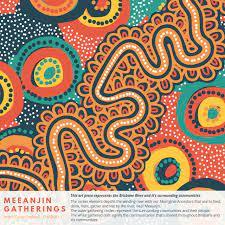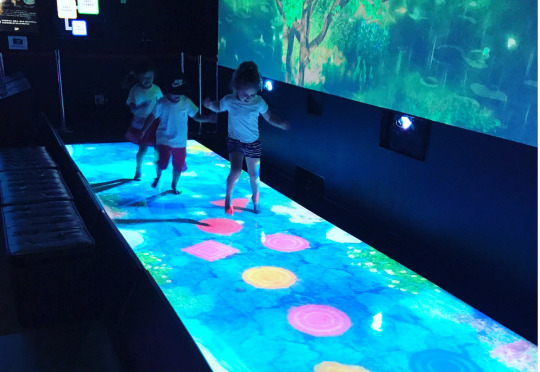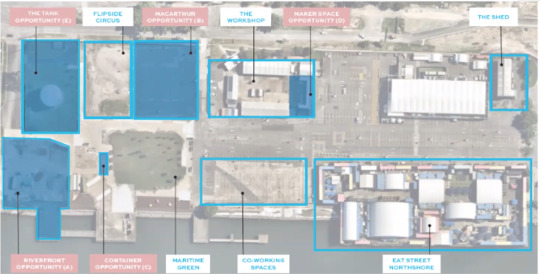Creative Concept Journal for Northshore Hamilton, Brisbane.
Don't wanna be here? Send us removal request.
Text
Step 6: Project Pitch
"Crochet Playscapes"


Using the "Riverfront" area, this project aims to create an immersive and creative space for children of up to and including 4-13 year olds. my concept of a crochet playground hopes to encourage children to put down their phones and learn in a physical, sensory-driven way. Through a combination of different textile fibre's, the patterns will be reflective of the Indigenous history through use of colour, shape and story. With a specific focus to the connection of the land and river to the Northshore site. Through tactile play, the children will be implicitly learning and be enriched with the culture, art and rich Aboriginal history of this area.
Skills Needed:
- Design skills (prototyping)
- Communication, public speaker and confident leader
- Budgeting and logistics planner
- Researcher
- Marketing
0 notes
Text
Step 5: Budget


This is an estimated cost of the project - of course this will vary according to size and structure.
0 notes
Text
Step 4: My Concept

Aboriginal art representing the connection of land and river. It is bright and vibrant to attract a younger audience.
The first painting, by Casey Coolwell, which promotes the Meeanjin Markets also symbolises the importance and centrality of the Brisbane river. This pattern/story is something I would like to see woven into my concept/playscape, to highlight the rich history of the river and the connection it has to the gathering of community and friends. As said by Coolwell, "the centre element depicts the winding river with our Aboriginal Ancestors that use to feed, drink, hunt, gather and live by the river, at Meeanjin. The outer gathering circles represent the surrounding communities and their people. The white gathered dots signify the communication that's shared throughout Brisbane and its communities."

Aboriginal colour palette, extremely representative of the earthy tones present at Northshore area. These are the colours I would like to see reflected on the crochet work.
Reference Photo 1: Casey Coolwell, 2018
Reference Photo 2: Kirk, H., Cook, D., Allan, A., Gayler, R., Peng, R., & Saber, E. (2017, Nov 21). RopenSci. Retrieved from OchRe - Australian themed colour palettes: https://ropensci.org/blog/2017/11/21/ochre/
0 notes
Text
Step 4: My Concept
I've decided to follow through with Idea 3: Crochet Playscape.
Responds to the Site & Client Brief:
- My concept activates the site by focusing on human experience and participation which will result in the area becoming a key destination for future visitors.
- It reflects the client's vision and brand. It's a multi-use concept for people to live, work and play; ultimately creating appeal and value in the area by embracing the sites history and adopting a strong innovation profile. My concept is highly interactive. It's energetic, creative, grounded and progressive. There is nothing similar to this in Brisbane.
Originality:
- My concept reflects the features of Northshore. It's a physical, interactive playscape.
- In order to establish comparability and uniqueness of my concept, elements of Aboriginal culture, history and art memorabilia will be added. Examples include colours of the yarn string will be symbolic of Indigenous art. The pattern will tell a story of the connection to the river and land of this space.
Audience Engagement:
- The structure, shape and form of my concept will hopefully encourage children to physically move their way through the playscape. They are not learning if they are just looking, instead they are learning in an embodied and sensory-driven way. The yarn itself - a stretchy nylon fabric - creates a unique opportunity for them to learn through tactile play (Apenfold, 2018). It's an environment that cultivates children's creativity through art.
- My idea is engaging and appealing to the area. When these two concepts combine they attract people to revisit the area overtime and enjoy the activity once again. It is a great space for kids to learn and play, but also for parents/carers to let them be independent while relaxing nearby.
Feasibility, Sustainability & Enduring Significance:
- This project has the potential to be adapted and sustained overtime. Studies show that it takes Toshiko almost 2/3 years to make (dependant on size). It is universal and enduring, and is not only an interactive space but public art.
- If we look at past Toshiko works, some of her playscape's were built in the 90s and are still around today. According to placemaking literature, there are multiple benefits that can be divided into social, ecological and economic criterions. Socially, it includes a sense of social connectedness and belonging, as well as a "general well-being through benefits of physical, psychological... and aesthetic benefits." Ecologically, you see improved biodiversity, health, ability to adapt and working with nature. Economically, you see an increased length of time spent on site, job creation or skill development, and increased property value (Mateo-Babiano, Hes, & Lee, 2019).
Reference: Apenfold, L. (2018, November 18). Art. Play. Children. Learning: Cultivation children's creativity through art. Retrieved from Toshiko Horiuchi MacAdam's giant crochet sculpture: http://www.louisapenfold.com/childrens-tactile-learning-toshiko-horiuchi-macadam/
Reference: Mateo-Babiano, I., Hes, D., & Lee, G. (2019). Placemaking Fundamentals for the Built Environment - Introduction . In I. Mateo-Babiano, D. Hes, & G. Lee, Placemaking Fundamentals for the Built Environment (pp. 1-11). Springer Singapore Pte. Limited.
0 notes
Text
Step 3: Brainstorm Ideas
IDEA 3: Crochet Playscape



Taking inspiration from artist Toshiko Horiuchi MacAdam, these colourful installations of yarn and string stretch across structures and outdoor environments offering massive interactive playgrounds. There are examples of similar works by different artists such as Ernesto Neto and Tomas Saraceno all over the world.
In order to make this project comparable to the other designs, I would add elements of Indigenous historical relevance and art to the concept.
Reference Photo 1: Charlotte, H. (2012, September 3). Handmade Charlotte. Retrieved from Amazing Playgrounds: https://www.handmadecharlotte.com/amazing-playscapes/
Reference Photo 3: Unknown
Reference Photo 3: Apenfold, L. (2018, November 18). Art. Play. Children. Learning: Cultivation children's creativity through art. Retrieved from Toshiko Horiuchi MacAdam's giant crochet sculpture: http://www.louisapenfold.com/childrens-tactile-learning-toshiko-horiuchi-macadam/
1 note
·
View note
Text
Step 3: Brainstorm Ideas
IDEA 2: Continued
A video I filmed from teamLabs Tokyo - it just highlights the space from a first-person perspective.
0 notes
Text
Step 3: Brainstorm Ideas
IDEA 2: Immersive Room Space


Taking inspiration from the TeamLabs Tokyo interactive technology, using the 'Markerspace' area seen on the map would be a creative and unique use of that space.
I went to Japan with my sister in 2019 before COVID started, for about 10 days. In these five days we wanted to fit in the best things to do in Japan. We landed on teamLabs and spent the day going through these rooms where you immerse your body within the environment and take in the three-dimensional world.
In doing this at Northshore, I would introduce aspects of Indigenous life and culture.
Reference Photo 2: Chapter, T. T. (2018, November 14). The Tokyo Chapter. Retrieved from Team Lab Fujimi & The Indoor Arcade that my Kids Just Love: https://www.thetokyochapter.com/team-lab-fujimi-the-indoor-arcade-that-my-kids-just-love/
Reference Photo 2: Tsai, I. (2020, Oct 12). Sora News. Retrieved from Amazing new exhibits from Japanese art team TeamLab coming to life in the USA: https://soranews24.com/2020/10/12/amazing-new-exhibits-from-japanese-art-team-teamlab-coming-to-life-in-the-u-s-a/
0 notes
Text
Step 3: Brainstorm Ideas
IDEA 1: Community Vegetable Garden

Community vegetable gardens around the world have been credited with multiple beneficial outcomes. These include local political activism and environmental education. There is also the opportunity for employment and local economic development in the form of markets and food operatives. Not only does gardens make community spaces look more appealing, but they are intrinsically linked with promoting physical and mental well-being (Thompson, Corkery & Judd, 2007).
There are multiple community gardens that surround Brisbane (some examples are Jane Street in West End, Little Farm in New Farm or The Pocket in Woolloongabba). However, in order to make Northshore comparable we could also add an elements of Indigenous life.
Reference: Thompson, S., Corkery, L., & Judd, B. (2007). Faculty of the Built Environment, UNSW. Retrieved from The Role of Community Gardens in Sustaining Healthy Communities: http://soac.fbe.unsw.edu.au/2007/SOAC/theroleofcommunitygardens.pdff
Reference Photo 1: Discovery Education . (2016, May 19). Discovery Education. Retrieved from Lively Lessons: Community Garden STEM Challenge: https://blog.discoveryeducation.com/blog/2016/05/19/lively-lessons-community-garden-stem-challenge/
0 notes
Text
Step 2: Identify Audience
My project aims to target children in primary school (4-13 years old). From starting school to entering puberty, ages 4-13 is a time of progress and development. My project encourages children to be interactive, creative and has hints of educational undertones. It will hopefully be a space where they feel comfortable to play and engage with others. It also accommodates the parents/carers and lets their children be independent and learn new skills.
Example persona of my target audience:
Name: Lara
Age: 7 years old
Interests: Playing with dolls, cooking with mum and colouring in
Lara is a bright and bubbly 7 year old girl. She loves to spend her time creating fictitious worlds and characters with her dolls, she also enjoys spending time with family and colouring in. She loves the outdoors and meeting new friends.
How do I grow this audience?
Though my concept aims to target the 4-13 year old audience segment, in order to grow the audience I'm looking to target the parents/carers who drive and take their children here. Hopefully, the parents will act as a source of 'free' advertising by taking images/videos of the space, posting on their social medias, and even word of mouth to their friends and families.
Why would my youth sector want to revisit my project?
My concept is energetic and creative, and it's different from usual playgrounds. It's a chance for them to be creative themselves while they play with other kids around their age.
Beneficiaries: Target Audience (4-13 years old) & Community
Client: Who pays (EDQ)
Stakeholders: Business Owners, Investors, Tourists, Media, Government Parties
0 notes
Text
Step 1: Observations / Reflections
Brand and Position

This highlights their key pillars:
Reference: EDQ. (2022). QUT Student Briefing. Retrieved from https://blackboard.qut.edu.au/bbcswebdav/pid-9666200-dt-content-rid-49229855_1/courses/KKB285_22se1/EDQ%20Client%20Briefing%20-%20slides%20-%20Sem%201%202022.pdf
0 notes
Text
Step 1: Observations / Reflections


Reference: EDQ. (2022). QUT Student Briefing. Retrieved from https://blackboard.qut.edu.au/bbcswebdav/pid-9666200-dt-content-rid-49229855_1/courses/KKB285_22se1/EDQ%20Client%20Briefing%20-%20slides%20-%20Sem%201%202022.pdf
0 notes
Text
Step 1: Observations / Reflections

Northshore Project Area (DOCK "C")
Reference: EDQ. (2022). QUT Student Briefing. Retrieved from https://blackboard.qut.edu.au/bbcswebdav/pid-9666200-dt-content-rid-49229855_1/courses/KKB285_22se1/EDQ%20Client%20Briefing%20-%20slides%20-%20Sem%201%202022.pdf
0 notes
Text
Step 1: Observations/Reflections
Project Criteria:
· Unique and innovative
· A place-based approach
· Budget ($40-70,000 AUD)
· Have an energetic, creative and grounded vibe to interact and increase the target audience.
· Environmentally and economically sustainable
· Deliverable (1-3 years)
Measurement of Success
1. Essential
- Draw attention to Northshore’s features
- Improve brand awareness / in-line with the vision
- Engage with youth target audience (5-18 yoa)
- A presentable physical and/or digital prototype
2. Desirable
- Respond directly to at least one of Northshore’s brand pillars
- Sustainable and enduring significance in order for future endeavours to happen overtime
- Attract return visitors and increase visitation
Reference: EDQ. (2022). QUT Student Briefing. Retrieved from https://blackboard.qut.edu.au/bbcswebdav/pid-9666200-dt-content-rid-49229855_1/courses/KKB285_22se1/EDQ%20Client%20Briefing%20-%20slides%20-%20Sem%201%202022.pdf
0 notes